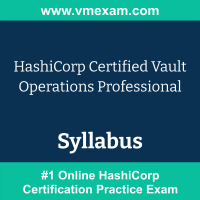 The HashiCorp Vault Operations Professional exam preparation guide is designed to provide candidates with necessary information about the Vault Operations Professional exam. It includes exam summary, sample questions, practice test, objectives and ways to interpret the exam objectives to enable candidates to assess the types of questions-answers that may be asked during the HashiCorp Certified - Vault Operations Professional exam.
The HashiCorp Vault Operations Professional exam preparation guide is designed to provide candidates with necessary information about the Vault Operations Professional exam. It includes exam summary, sample questions, practice test, objectives and ways to interpret the exam objectives to enable candidates to assess the types of questions-answers that may be asked during the HashiCorp Certified - Vault Operations Professional exam.
It is recommended for all the candidates to refer the Vault Operations Professional objectives and sample questions provided in this preparation guide. The HashiCorp Vault Operations Professional certification is mainly targeted to the candidates who want to build their career in Security Automation domain and demonstrate their expertise. We suggest you to use practice exam listed in this cert guide to get used to with exam environment and identify the knowledge areas where you need more work prior to taking the actual HashiCorp Certified Vault Operations Professional exam.
HashiCorp Vault Operations Professional Exam Summary:
|
Exam Name
|
HashiCorp Certified Vault Operations Professional |
| Exam Code | Vault Operations Professional |
| Exam Price | $295 USD |
| Duration | 240 minutes |
| Number of Questions | 57 |
| Passing Score | Pass / Fail (Approx 70%) |
| Recommended Training / Books | Prepare for the exam |
| Schedule Exam | Cloud Engineer Certification Exam Portal |
| Sample Questions | HashiCorp Vault Operations Professional Sample Questions |
| Recommended Practice | HashiCorp Certified - Vault Operations Professional Practice Test |
HashiCorp Vault Operations Professional Syllabus:
| Section | Objectives |
|---|---|
| Create a working Vault server configuration given a scenario |
- Enable and configure secret engines - Practice production hardening - Auto unseal Vault - Implement integrated storage for Community and Enterprise Vault - Enable and configure authentication methods - Practice secure Vault initialization - Regenerate a root token - Rekey Vault and rotate encryption keys |
| Monitor a Vault environment |
- Monitor and understand Vault telemetry - Monitor and understand Vault audit logs - Monitor and understand Vault operational logs |
| Employ the Vault security model |
- Describe secure introduction of Vault clients - Describe the security implications of running Vault in Kubernetes |
| Build fault-tolerant Vault environments |
- Configure a highly available (HA) cluster - [Vault Enterprise] Enable and configure disaster recovery (DR) replication - [Vault Enterprise] Promote a secondary cluster |
| Understand the hardware security module (HSM) integration |
- [Vault Enterprise] Describe the benefits of auto unsealing with HSM - [Vault Enterprise] Describe the benefits and use cases of seal wrap (PKCS#11) |
| Scale Vault for performance |
- Use batch tokens - [Vault Enterprise] Describe the use cases of performance standby nodes - [Vault Enterprise] Enable and configure performance replication - [Vault Enterprise] Create a paths filter |
| Configure access control |
- Interpret Vault identity entities and groups - Write, deploy, and troubleshoot ACL policies - [Vault Enterprise] Understand Sentinel policies - [Vault Enterprise] Define control groups and describe their basic workflow - [Vault Enterprise] Describe and interpret multi-tenancy with namespaces |
| Configure Vault Agent |
- Securely configure auto-auth and token sink - Configure templating |
